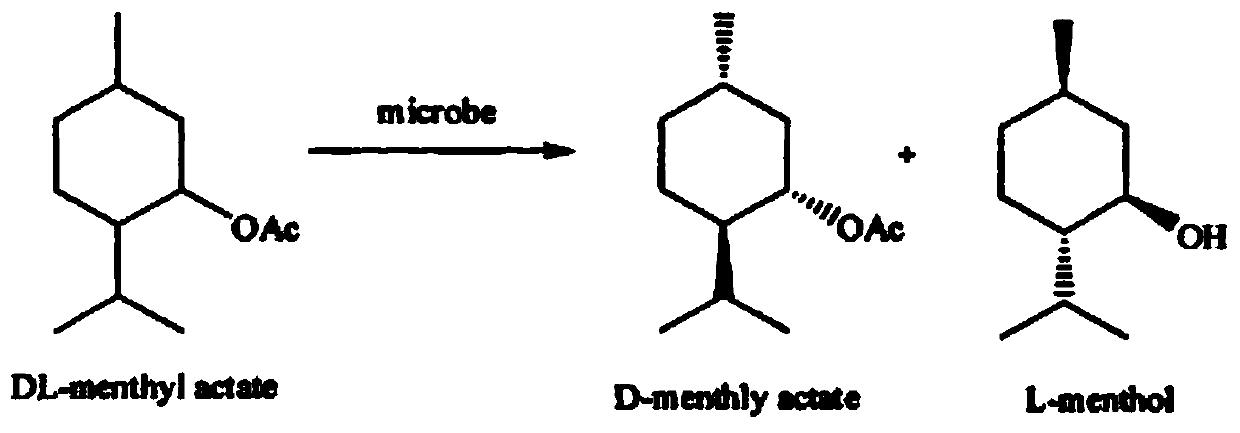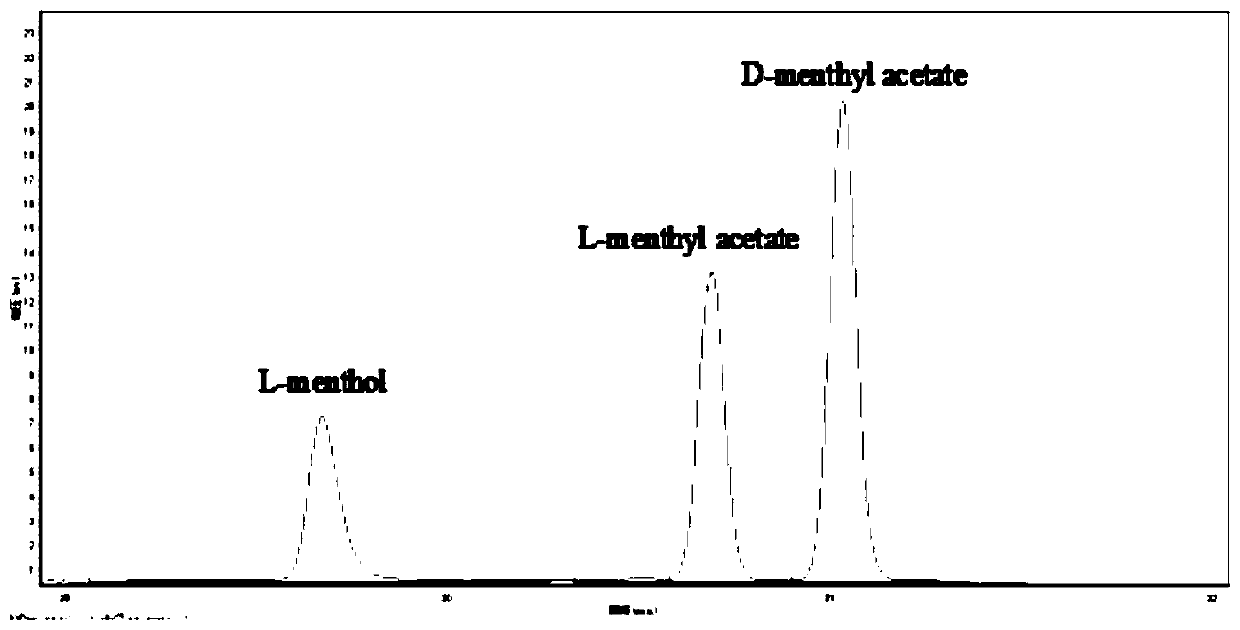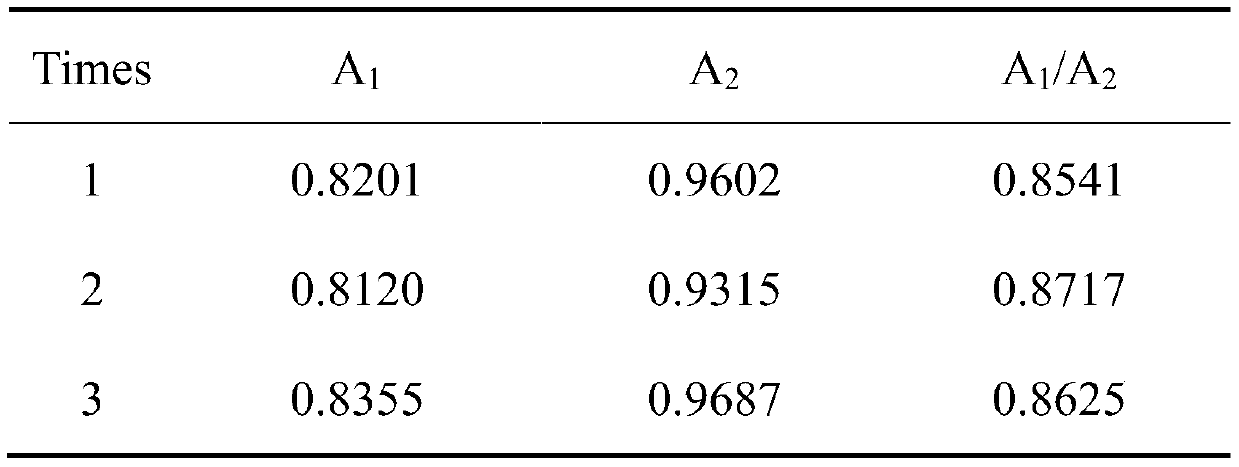Bacillus subtilis and method of using same to prepare L-menthol
A technology of Bacillus subtilis and menthol, applied in the field of L-menthol preparation, can solve problems such as affecting catalytic function, inactivation, and variability, and achieve the effects of reducing purification cost, changing substrate specificity, and increasing solubility
- Summary
- Abstract
- Description
- Claims
- Application Information
AI Technical Summary
Problems solved by technology
Method used
Image
Examples
Embodiment 1
[0032] Embodiment 1: the screening of Bacillus subtilis:
[0033] (1) Primary screening: Bacillus subtilis strains screened from the soil and stored in a -80°C refrigerator. Take the strains stored in the -80°C refrigerator and melt in 40°C water; 250mL shake flask, 20% liquid volume (seed medium: (g / L): peptone 10.0, yeast powder 5.0, NaCl 10.0, pH 7.0, 121°C , 20min, high-pressure steam sterilization), inoculum size 50μL, 30°C, 150rpm culture overnight activation;
[0034] Take 100 μL of the culture solution and add it to a 250mL shake flask, the filling volume is 20% (fermentation medium: (g / L): peptone 5.0, yeast powder 2.0, (NH4) 2 SO 4 2.0, sucrose 3.0, anhydrous K 2 HPO 4 2.0, NaCl 1.0, anhydrous MgSO 4 0.2, olive oil 10 (add separately after subpackaging), pH 7.0, 115°C, 20min, high-pressure steam sterilization), 30°C, 150rpm for 24h;
[0035]Get 25mL of fermentation broth and centrifuge (8000rpm, 5min), remove the supernatant, and the gained thalline precipit...
Embodiment 2
[0053] Embodiment 2: the solvent selection of preparing L-menthol by catalytic hydrolysis
[0054] Centrifuge (7000rpm, 10min) 25mL of the fermented culture solution of Example 1, remove the supernatant, and the gained thallus is placed in a 50mL Erlenmeyer flask, adding 20ml concentration is the buffer solution disodium hydrogen phosphate-sodium dihydrogen phosphate of 0.1mol / L With substrate DL-mentha acetate, so that the substrate concentration is 2000ppm, add water, organic reaction solvent methanol, ethanol, isopropanol, n-butanol, acetone, or DMSO respectively, so that their final concentration is 20wt%, Seal with parafilm, hydrolyze at 30°C and 150rpm. During the reaction, use 0.1mol / L KOH solution to control the reaction pH to 6.5. After 20h, add twice the volume of organic solvent ethyl acetate for extraction, gas phase CP chiral column detection, Determination of enzyme activity and e.e. p . The results are shown in Table 2.
[0055] The influence of table 2 diffe...
Embodiment 3
[0061] Embodiment 3: add the preparation process of activating ion
[0062] Centrifuge (7000rpm, 10min) 25mL of the fermented culture solution of Example 1, remove the supernatant, and the gained thallus is placed in a 50mL Erlenmeyer flask, adding 20ml concentration is the buffer solution disodium hydrogen phosphate-sodium dihydrogen phosphate of 0.1mol / L and substrate DL-menth acetate, so that the concentration of the substrate is 2000ppm, add organic reaction solvent methanol, so that the concentration is 20wt%, and then add the activation ion K + 、Na + , NH 4 + etc., the amount of activating ions added is the final concentration of 5mmol / L; the sealing film is sealed, 30°C, 150rpm for hydrolysis, during the reaction, use 0.1mol / L KOH solution to control the reaction pH to 6.5. After 20h, add twice the volume Organic solvent ethyl acetate extraction, gas phase CP chiral column detection, determination of enzyme activity and e.e. p . The results are shown in Table 3.
...
PUM
 Login to View More
Login to View More Abstract
Description
Claims
Application Information
 Login to View More
Login to View More - R&D
- Intellectual Property
- Life Sciences
- Materials
- Tech Scout
- Unparalleled Data Quality
- Higher Quality Content
- 60% Fewer Hallucinations
Browse by: Latest US Patents, China's latest patents, Technical Efficacy Thesaurus, Application Domain, Technology Topic, Popular Technical Reports.
© 2025 PatSnap. All rights reserved.Legal|Privacy policy|Modern Slavery Act Transparency Statement|Sitemap|About US| Contact US: help@patsnap.com



